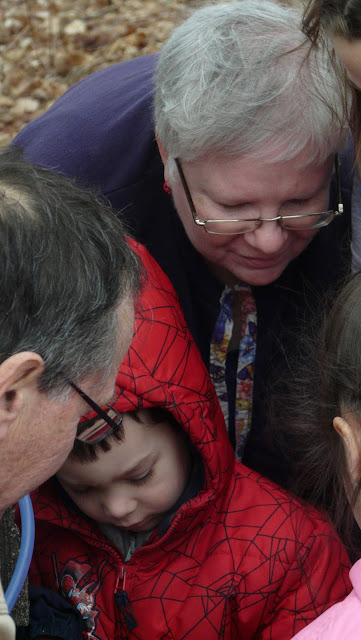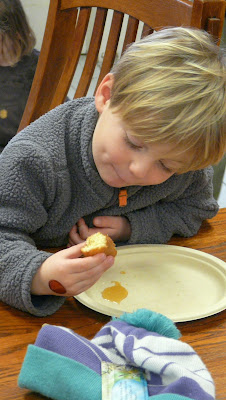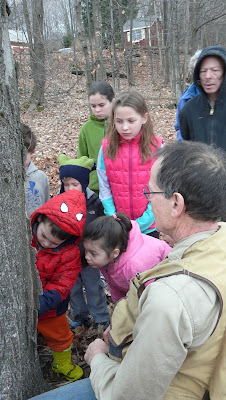Originally published 3/1/2017
Colleen Koniak, Library Director, Jericho Town Library hosted "tap the library maple trees" with Tom Baribault of Birch Hill Sugar Works. (March 2017) The weather cooperated, to allow us to watch the sap run. We learned about maple sugar grades and many interesting historical as well as current information about maple sap, maple syrup, and the process in between. There was also maple syrup to taste.
The event started with Colleen reading a story about maple sugaring. A dozen children engaged Colleen throughout the story. Next, Tom Baribault of Birch Hill Sugar Works proceeded to inform us about some of the histories of maple sugaring up to current sap gathering and processing steps. Tom comes across as a knowledgeable and attention-holding educator - to all ages.
Here is some of the sweet history of maple sugaring that Tom shared with us.
Indigenous people of a century or so ago, observed that animals like red squirrels bit into the bark of Sugar Maple trees, and later came back to lick at the sap (as they still do today). From there Indigenous people determined a process of using hatchets to open cuts in the maple trees to acquire maple sap. They then used birch bark buckets (they had no metal or glass containers at least early on) to collect the sap. Next, they created bonfires to heat large stones which were dropped into the sap buckets to boil away the water. Since carrying and storing liquid was not easy to do, the boiling process continued beyond the maple syrup product to get to Indian Sugar, or Maple Sugar as we call it today. This was a valuable nutritious food that could be easily transported and stored for long periods of time.
Europeans learned this from the Indigenous people and refined the process. Drilling a small diameter hole in the tree (with a hand auger) replaced hatchet cuts, to minimize individual tree damage. A maple tree can live from 200 to 250 years. Europeans also created spouts to insert in the holes to direct the sap out and away from the tree into buckets.
In current times, sugar makers use metal, plastic, or glass spouts. Black plastic spouts are sometimes used on the north-facing holes to aid the warming of frozen sap inside the tree and increase sap flow there.
 |
| Always use a rubber hammer to help install the spout to avoid unnecessary damage to the tree. |
Plastic tubing is attached to the spout and the other end of the tubing runs down into a bucket hanging on the tree. The tubing not only directs the sap flow into the bucket but also creates suction, aiding the sap flow.
Sugar bushes may contain hundreds if not thousands of maple trees being tapped. It is often more efficient to run plastic tubing from each tree to a central line that runs to a large holding tank.
Typical maple sap is 2% sugar or sucrose; a really good tree will reach 4% to 5% sugar, and a poor tree only 1% or less. Birch trees are also sometimes tapped for their sap to make distilled spirits or liquor as well as sweet concoctions. However birch sap is usually less than 1% sugar, therefore requires much more sap and much more boiling to reach the final product.
 To determine how much sap will need to make a gallon of syrup, one can use the Jones rule (from a past UVM professor) which is to divide 86 by the sugar content of the sap. Keep in mind that if you need 43 gallons of sap to make one gallon of maple syrup, you have to boil away 42 gallons of water - a good reason to boil sap in a sugarhouse instead of your living quarters. (Unless you are looking for a way to make wallpaper fall off the walls!)
To determine how much sap will need to make a gallon of syrup, one can use the Jones rule (from a past UVM professor) which is to divide 86 by the sugar content of the sap. Keep in mind that if you need 43 gallons of sap to make one gallon of maple syrup, you have to boil away 42 gallons of water - a good reason to boil sap in a sugarhouse instead of your living quarters. (Unless you are looking for a way to make wallpaper fall off the walls!)
Sugarmakers place maple syrup for use and for sale into plastic, metal, or glass containers (in very large sugar bushes they may use barrels). One advantage to using glass is that the aesthetics of the maple syrup are quite pleasing in and of themselves.
A sugarmaker must be diligent and informed about the entire process. For example, there are three types of maple trees: sugar or rock maple, red or soft maple, and silver maple. Without leaves in the winter and early spring, and with similar bark, it can take a knowledgeable eye to tell them apart.
Drilling trees does do some harm to the trees, leaving an opening that is susceptible to infection and insects. Trees heal themselves by sealing the hole over 6 to 8 weeks.
Sap flows both up and down (down when frozen sap is higher up in the tree thaws). However, sap will not flow near the area of a previous year's drilled hole for up to 10 years - until enough new growth and diameter allow the sap to again flow in that section of the tree. So sugarmakers need to choose carefully each year, where to drill new holes so as not to damage the tree to the point where sap cannot flow and the tree dies as a result.
Tight control over the temperature of the heat used to boil the sap, detailed preparation, squeaky clean equipment, and boiling sap only just the right amount (if done properly, maple syrup is 67% natural sugar) are just a few more steps of the recipe the sugarmaker must follow within tight parameters to ensure a quality product that earns the title "Vermont Maple Syrup".
There are different grades of maple syrup (mostly controlled by nature) and loosely the best choice for each individual is related to how strong of a maple flavor they prefer. The ideal way to determine this is to taste a sample of each of the grades of maple syrup to decide which you prefer the most.
A great time to do this as well as to learn more about turning sap into maple syrup and actually see the process of making maple syrup for yourselves is during the Vermont Sugarmakers Maple Syrup Open House when you can visit several different sugar makers in Vermont. View the Maple Sugar Makers Association website for more details. http://vermontmaple.org/
The 2017 open house is on March 26 and 27.
Birch Hill Sugarworks is located on Browns Trace in Jericho VT. Visit Tom and his wife to purchase maple syrup and view their Facebook page @
https://www.facebook.com/BirchHillSugarworks/
For an idea of what you might experience at one of these open house Sugarhouses, view the photo posting of my 2013 sugarhouse visits @ https://litterwithastorytotell.blogspot.com/2013/03/vermont-maple-open-house-weekend.html
View the Maple Sugar Makers Association website for more Sugarmakers Open House details @ http://vermontmaple.org/
The 2017 open house is on March 26 and 27.
Also view Maple, Murals, Sugarhouses, and Sculptures @
Stop, Look, and Listen. Observe Nature and she will astound you.
~Bernie































No comments:
Post a Comment